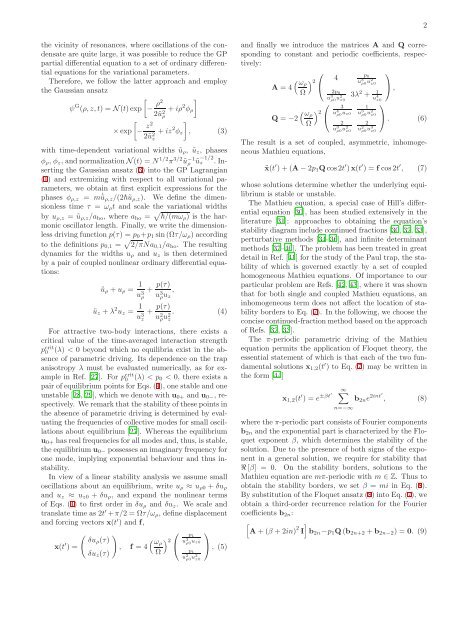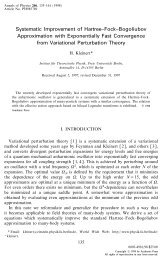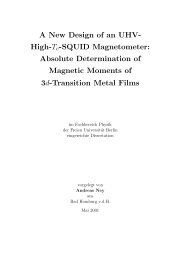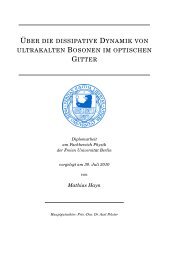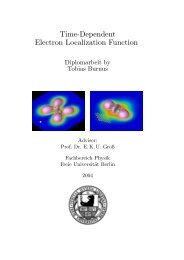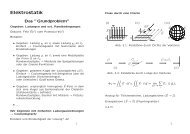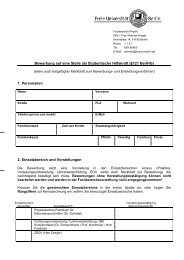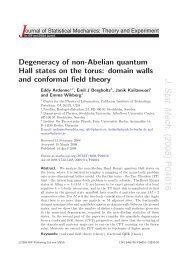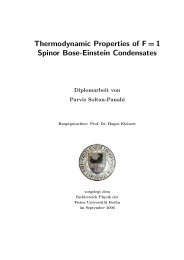Technical University Kaiserslautern Preprint - Fachbereich Physik ...
Technical University Kaiserslautern Preprint - Fachbereich Physik ...
Technical University Kaiserslautern Preprint - Fachbereich Physik ...
Create successful ePaper yourself
Turn your PDF publications into a flip-book with our unique Google optimized e-Paper software.
2<br />
the vicinity of resonances, where oscillations of the condensate<br />
are quite large, it was possible to reduce the GP<br />
partial differential equation to a set of ordinary differential<br />
equations for the variational parameters.<br />
Therefore, we follow the latter approach and employ<br />
the Gaussian ansatz<br />
]<br />
ψ G (ρ,z,t) = N(t)exp<br />
[− ρ2<br />
+iρ 2 φ ρ<br />
2ũ 2 ρ<br />
]<br />
×exp<br />
[− z2<br />
2ũ 2 +iz 2 φ z , (3)<br />
z<br />
with time-dependent variational widths ũ ρ , ũ z , phases<br />
φ ρ , φ z , andnormalizationN(t) = N 1/2 π 3/2 ũ −1<br />
ρ ũ−1/2 z .Inserting<br />
the Gaussian ansatz (3) into the GP Lagrangian<br />
(1) and extremizing with respect to all variational parameters,<br />
we obtain at first explicit expressions for the<br />
phases φ ρ,z = m˙ũ ρ,z /(2ũ ρ,z ). We define the dimensionless<br />
time τ = ω ρ t and scale the variational widths<br />
by u ρ,z = ũ ρ,z /a ho , where a ho = √ /(mω ρ ) is the harmonic<br />
oscillator length. Finally, we write the dimensionless<br />
driving function p(τ) = p 0 +p 1 sin(Ωτ/ω ρ ) according<br />
to the definitions p 0,1 = √ 2/πNa 0,1 /a ho . The resulting<br />
dynamics for the widths u ρ and u z is then determined<br />
by a pair of coupled nonlinear ordinary differential equations:<br />
ü ρ +u ρ = 1 u 3 ρ<br />
ü z +λ 2 u z = 1 u 3 z<br />
+ p(τ)<br />
u 3 ρu z<br />
,<br />
+ p(τ)<br />
u 2 ρu 2 . (4)<br />
z<br />
For attractive two-body interactions, there exists a<br />
critical value of the time-averaged interaction strength<br />
p crit<br />
0 (λ) < 0 beyond which no equilibria exist in the absence<br />
of parametric driving. Its dependence on the trap<br />
anisotropy λ must be evaluated numerically, as for example<br />
in Ref. [27]. For p crit<br />
0 (λ) < p 0 < 0, there exists a<br />
pair ofequilibrium points for Eqs. (4), one stable and one<br />
unstable [28, 29], which we denote with u 0+ and u 0− , respectively.<br />
Weremarkthatthe stabilityofthesepointsin<br />
the absence of parametric driving is determined by evaluating<br />
the frequencies of collective modes for small oscillations<br />
about equilibrium [27]. Whereas the equilibrium<br />
u 0+ hasrealfrequenciesforallmodesand, thus, is stable,<br />
the equilibrium u 0− possessesanimaginaryfrequencyfor<br />
one mode, implying exponential behaviour and thus instability.<br />
In view of a linear stability analysis we assume small<br />
oscillations about an equilibrium, write u ρ ≈ u ρ0 + δu ρ<br />
and u z ≈ u z0 + δu ρ , and expand the nonlinear terms<br />
of Eqs. (4) to first order in δu ρ and δu z . We scale and<br />
translate time as 2t ′ +π/2 = Ωτ/ω ρ , define displacement<br />
and forcing vectors x(t ′ ) and f,<br />
( ) ⎛<br />
p<br />
δuρ (τ) (<br />
x(t ′ ωρ<br />
)<br />
1<br />
⎞<br />
2 u<br />
) = , f = 4 ⎝<br />
3 ρ0 uz0<br />
⎠, (5)<br />
δu z (τ) Ω<br />
p 1<br />
u 2 ρ0 u2 z0<br />
and finally we introduce the matrices A and Q corresponding<br />
to constant and periodic coefficients, respectively:<br />
A = 4<br />
Q = −2<br />
⎛<br />
( ωρ<br />
) 2<br />
⎝<br />
Ω<br />
⎛<br />
( ωρ<br />
) 2<br />
⎝<br />
Ω<br />
4<br />
2p 0<br />
u 3 ρ0 u2 z0<br />
p 0<br />
u 3 ρ0 u2 z0<br />
3λ 2 + 1<br />
u 4 z0<br />
3<br />
u 4 ρ0 uz0 1<br />
u 3 ρ0 u2 z0<br />
2<br />
u 3 ρ0 u2 z0<br />
2<br />
u 2 ρ0 u3 z0<br />
⎞<br />
⎞<br />
⎠,<br />
⎠. (6)<br />
The result is a set of coupled, asymmetric, inhomogeneous<br />
Mathieu equations,<br />
ẍ(t ′ )+(A−2p 1 Qcos2t ′ )x(t ′ ) = f cos2t ′ , (7)<br />
whose solutions determine whether the underlying equilibrium<br />
is stable or unstable.<br />
The Mathieu equation, a special case of Hill’s differential<br />
equation [30], has been studied extensively in the<br />
literature [31]: approaches to obtaining the equation’s<br />
stability diagram include continued fractions [30, 32, 33],<br />
perturbative methods [34–36], and infinite determinant<br />
methods [37–40]. The problem has been treated in great<br />
detail in Ref. [41] for the study of the Paul trap, the stability<br />
of which is governed exactly by a set of coupled<br />
homogeneous Mathieu equations. Of importance to our<br />
particular problem are Refs. [42, 43], where it was shown<br />
that for both single and coupled Mathieu equations, an<br />
inhomogeneous term does not affect the location of stability<br />
borders to Eq. (7). In the following, we choose the<br />
concisecontinued-fractionmethod basedontheapproach<br />
of Refs. [32, 33].<br />
The π-periodic parametric driving of the Mathieu<br />
equation permits the application of Floquet theory, the<br />
essential statement of which is that each of the two fundamental<br />
solutions x 1,2 (t ′ ) to Eq. (7) may be written in<br />
the form [44]<br />
x 1,2 (t ′ ) = e ±βt′<br />
∞ ∑<br />
n=−∞<br />
b 2n e 2int′ , (8)<br />
where the π-periodic part consists of Fourier components<br />
b 2n and the exponential part is characterized by the Floquet<br />
exponent β, which determines the stability of the<br />
solution. Due to the presence of both signs of the exponent<br />
in a general solution, we require for stability that<br />
R[β] = 0. On the stability borders, solutions to the<br />
Mathieu equation are mπ-periodic with m ∈ Z. Thus to<br />
obtain the stability borders, we set β = mi in Eq. (8).<br />
By substitution of the Floquet ansatz(8) into Eq. (7), we<br />
obtain a third-order recurrence relation for the Fourier<br />
coefficients b 2n :<br />
[ ]<br />
A+(β +2in) 2 I b 2n −p 1 Q(b 2n+2 +b 2n−2 ) = 0. (9)


